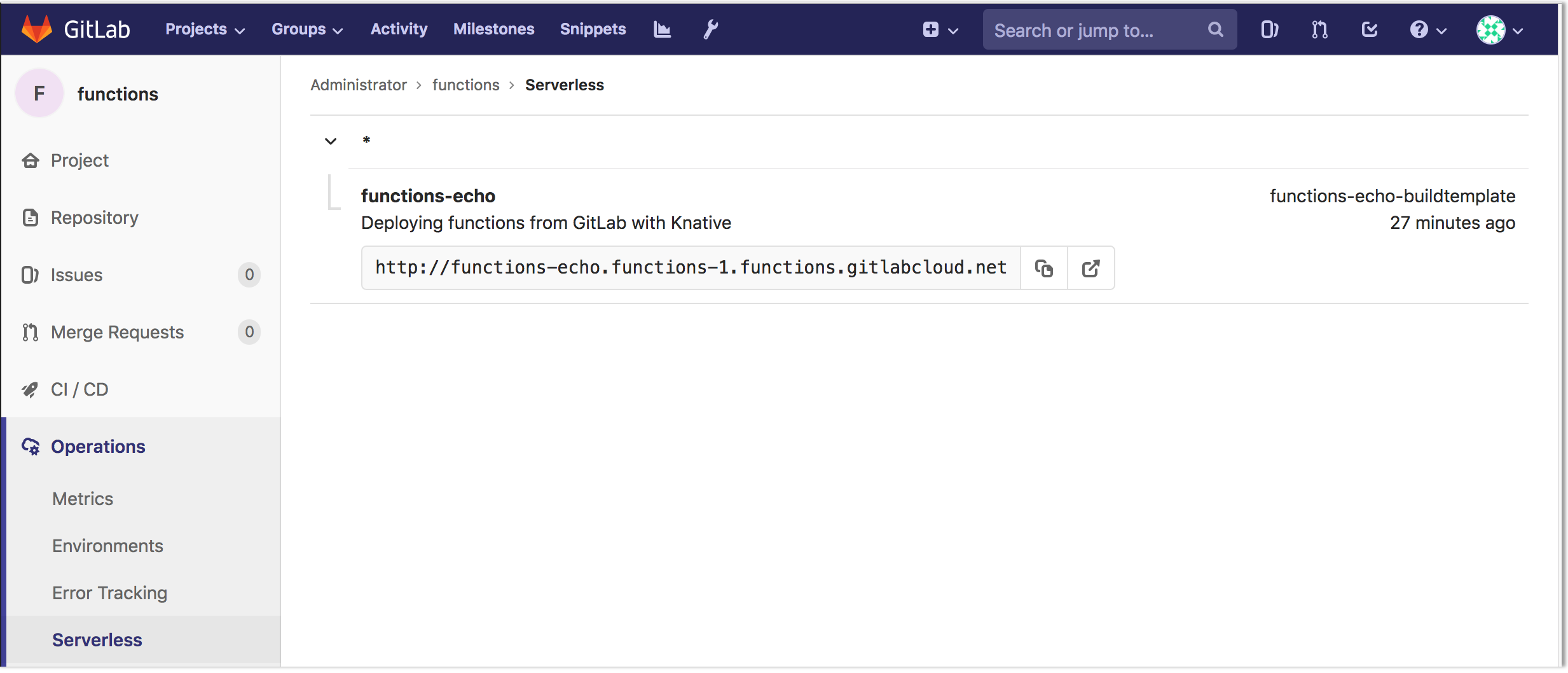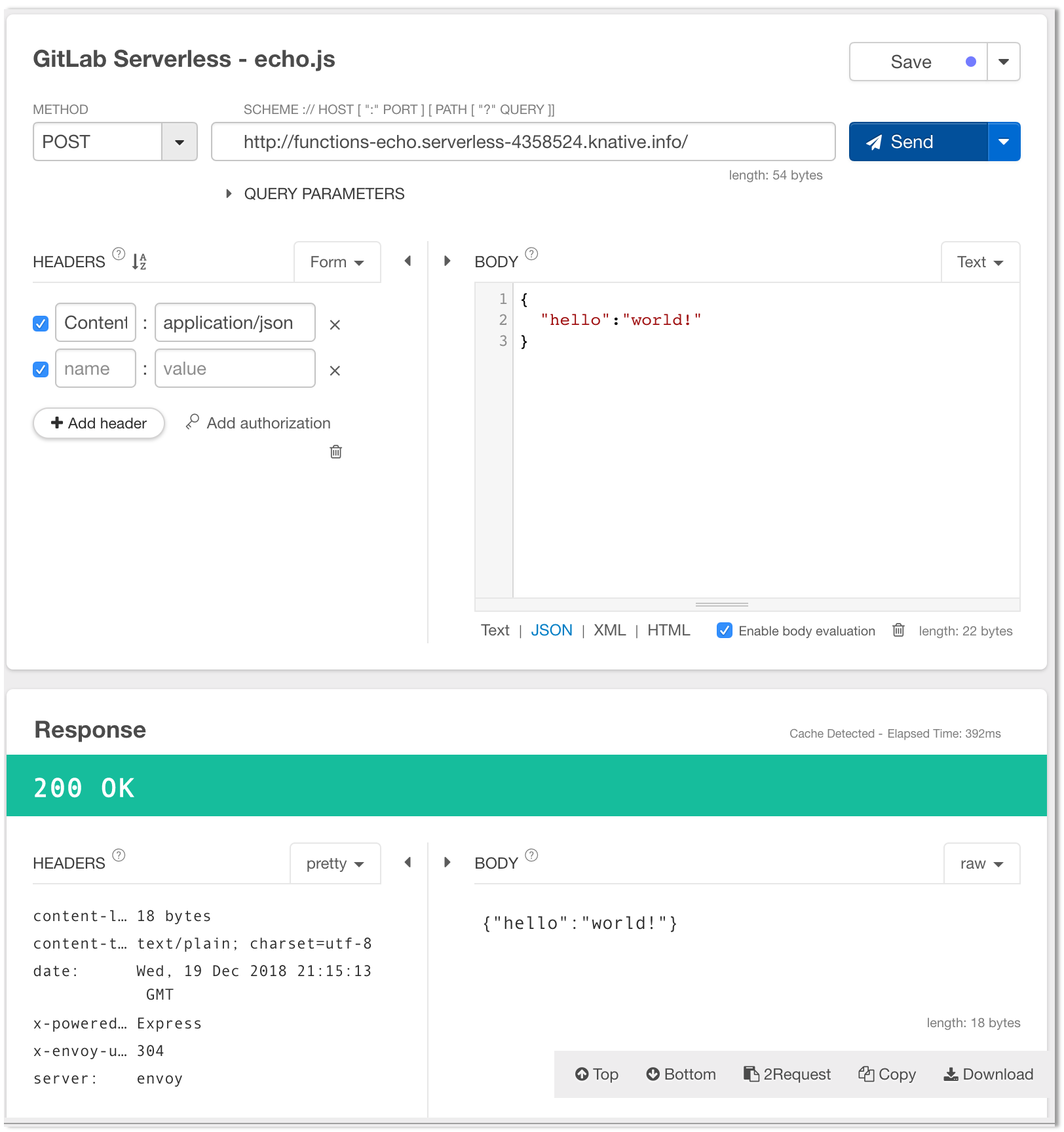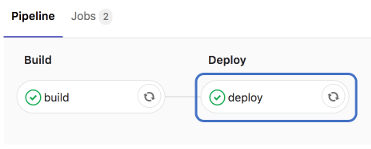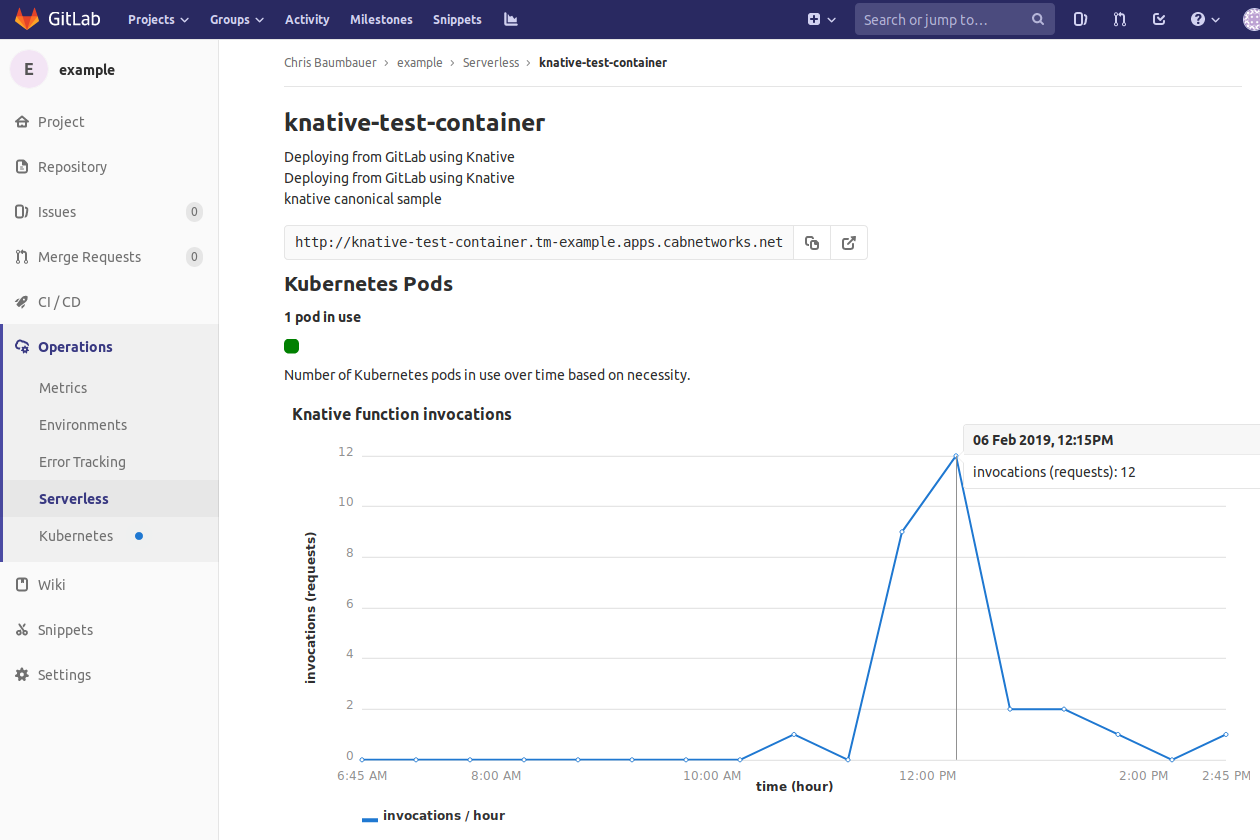Serverless
Introduced in GitLab 11.5.
CAUTION: Caution: Serverless is currently in alpha.
Run serverless workloads on Kubernetes using Knative.
Overview
Knative extends Kubernetes to provide a set of middleware components that are useful to build modern, source-centric, container-based applications. Knative brings some significant benefits out of the box through its main components:
- Serving: Request-driven compute that can scale to zero.
- Eventing: Management and delivery of events.
For more information on Knative, visit the Knative docs repo.
With GitLab Serverless, you can deploy both functions-as-a-service (FaaS) and serverless applications.
Prerequisites
To run Knative on Gitlab, you will need:
-
Existing GitLab project: You will need a GitLab project to associate all resources. The simplest way to get started:
- If you are planning on deploying functions, clone the functions example project to get started.
- If you are planning on deploying a serverless application, clone the sample Knative Ruby App to get started.
-
Kubernetes Cluster: An RBAC-enabled Kubernetes cluster is required to deploy Knative. The simplest way to get started is to add a cluster using GitLab's GKE integration. The set of minimum recommended cluster specifications to run Knative is 3 nodes, 6 vCPUs, and 22.50 GB memory.
-
Helm Tiller: Helm is a package manager for Kubernetes and is required to install Knative.
-
GitLab Runner: A runner is required to run the CI jobs that will deploy serverless applications or functions onto your cluster. You can install the GitLab Runner onto the existing Kubernetes cluster. See Installing Applications for more information.
-
Domain Name: Knative will provide its own load balancer using Istio. It will provide an external IP address or hostname for all the applications served by Knative. You will be prompted to enter a wildcard domain where your applications will be served. Configure your DNS server to use the external IP address or hostname for that domain.
-
.gitlab-ci.yml: GitLab uses Kaniko to build the application. We also use gitlabktl and TriggerMesh CLI CLIs to simplify the deployment of services and functions to Knative. -
serverless.yml(for functions only): When using serverless to deploy functions, theserverless.ymlfile will contain the information for all the functions being hosted in the repository as well as a reference to the runtime being used. -
Dockerfile(for applications only: Knative requires aDockerfilein order to build your applications. It should be included at the root of your project's repo and expose port8080.Dockerfileis not require if you plan to build serverless functions using our runtimes. -
Prometheus (optional): Installing Prometheus allows you to monitor the scale and traffic of your serverless function/application. See Installing Applications for more information.
Installing Knative via GitLab's Kubernetes integration
NOTE: Note: The minimum recommended cluster size to run Knative is 3-nodes, 6 vCPUs, and 22.50 GB memory. RBAC must be enabled.
-
Once Helm has been successfully installed, scroll down to the Knative app section. Enter the domain to be used with your application/functions (e.g.
example.com) and click Install. -
After the Knative installation has finished, you can wait for the IP address or hostname to be displayed in the Knative Endpoint field or retrieve the Istio Ingress Endpoint manually.
NOTE: Note: Running
kubectlcommands on your cluster requires setting up access to the cluster first. For clusters created on GKE, see GKE Cluster Access, for other platforms Install kubectl. -
The ingress is now available at this address and will route incoming requests to the proper service based on the DNS name in the request. To support this, a wildcard DNS A record should be created for the desired domain name. For example, if your Knative base domain is
knative.infothen you need to create an A record or CNAME record with domain*.knative.infopointing the ip address or hostname of the ingress.
NOTE: Note:
You can deploy either functions or serverless applications
on a given project but not both. The current implementation makes use of a serverless.yml file to signal a FaaS project.
Using an existing installation of Knative
Introduced in GitLab 12.0.
NOTE: Note: The "invocations" monitoring feature of GitLab serverless will not work when adding an existing installation of Knative.
It is also possible to use GitLab Serverless with an existing Kubernetes cluster which already has Knative installed.
Simply:
- Follow the steps to add an existing Kubernetes cluster.
- Follow the steps to deploy functions or serverless applications onto your cluster.
Deploying functions
Introduced in GitLab 11.6.
Using functions is useful for dealing with independent events without needing to maintain a complex unified infrastructure. This allows you to focus on a single task that can be executed/scaled automatically and independently.
Currently the following runtimes are offered:
- ruby
- node.js
- Dockerfile
You can find and import all the files referenced in this doc in the functions example project.
Follow these steps to deploy a function using the Node.js runtime to your Knative instance (you can skip these steps if you've cloned the example project):
-
Create a directory that will house the function. In this example we will create a directory called
echoat the root of the project. -
Create the file that will contain the function code. In this example, our file is called
echo.jsand is located inside theechodirectory. If your project is:- Public, continue to the next step.
- Private, you will need to create a GitLab deploy token with
gitlab-deploy-tokenas the name and theread_registryscope.
-
.gitlab-ci.yml: this defines a pipeline used to deploy your functions. It must be included at the root of your repository:include: template: Serverless.gitlab-ci.yml functions:build: extends: .serverless:build:functions environment: production functions:deploy: extends: .serverless:deploy:functions environment: productionThis
.gitlab-ci.ymlcreates jobs that invoke some predefined commands to build and deploy your functions to your cluster.Serverless.gitlab-ci.ymlis a template that allows customization. You can either import it withincludeparameter and useextendsto customize your jobs, or you can inline the entire template by choosing it from Apply a template dropdown when editing the.gitlab-ci.ymlfile through the user interface. -
serverless.yml: this file contains the metadata for your functions, such as name, runtime, and environment.It must be included at the root of your repository. The following is a sample
echofunction which shows the required structure for the file.You can find the relevant files for this project in the functions example project.
service: functions description: "GitLab Serverless functions using Knative" provider: name: triggermesh environment: FOO: value functions: echo-js: handler: echo-js source: ./echo-js runtime: https://gitlab.com/gitlab-org/serverless/runtimes/nodejs description: "node.js runtime function" environment: MY_FUNCTION: echo-js
Explanation of the fields used above:
service
| Parameter | Description |
|---|---|
service |
Name for the Knative service which will serve the function. |
description |
A short description of the service. |
provider
| Parameter | Description |
|---|---|
name |
Indicates which provider is used to execute the serverless.yml file. In this case, the TriggerMesh tm CLI. |
environment |
Includes the environment variables to be passed as part of function execution for all functions in the file, where FOO is the variable name and BAR are he variable contents. You may replace this with you own variables. |
functions
In the serverless.yml example above, the function name is echo and the subsequent lines contain the function attributes.
| Parameter | Description |
|---|---|
handler |
The function's name. |
source |
Directory with sources of a functions. |
runtime |
The runtime to be used to execute the function. |
description |
A short description of the function. |
environment |
Sets an environment variable for the specific function only. |
After the gitlab-ci.yml template has been added and the serverless.yml file has been
created, pushing a commit to your project will result in a
CI pipeline being executed which will deploy each function as a Knative service.
Once the deploy stage has finished, additional details for the function will
appear under Operations > Serverless.
This page contains all functions available for the project, the description for accessing the function, and, if available, the function's runtime information. The details are derived from the Knative installation inside each of the project's Kubernetes cluster. Click on each function to obtain detailed scale and invocation data.
The function details can be retrieved directly from Knative on the cluster:
kubectl -n "$KUBE_NAMESPACE" get services.serving.knative.devThe sample function can now be triggered from any HTTP client using a simple POST call:
-
Using curl (replace the URL on the last line with the URL of your application):
curl \ --header "Content-Type: application/json" \ --request POST \ --data '{"GitLab":"FaaS"}' \ http://functions-echo.functions-1.functions.example.com/ -
Using a web-based tool (ie. postman, restlet, etc)
Deploying Serverless applications
Introduced in GitLab 11.5.
NOTE: Note: You can reference and import the sample Knative Ruby App to get started.
Add the following .gitlab-ci.yml to the root of your repository
(you may skip this step if you've previously cloned the sample Knative Ruby App mentioned above):
include:
template: Serverless.gitlab-ci.yml
build:
extends: .serverless:build:image
deploy:
extends: .serverless:deploy:imageServerless.gitlab-ci.yml is a template that allows customization.
You can either import it with include parameter and use extends to
customize your jobs, or you can inline the entire template by choosing it
from Apply a template dropdown when editing the .gitlab-ci.yml file through
the user interface.
Deploy the application with Knative
With all the pieces in place, the next time a CI pipeline runs, the Knative application will be deployed. Navigate to CI/CD > Pipelines and click the most recent pipeline.
Obtain the URL for the Knative deployment
Go to the CI/CD > Pipelines and click on the pipeline that deployed your app. Once all the stages of the pipeline finish, click the deploy stage.
The output will look like this:
Running with gitlab-runner 11.5.0~beta.844.g96d88322 (96d88322)
on docker-auto-scale 72989761
Using Docker executor with image gcr.io/triggermesh/tm@sha256:e3ee74db94d215bd297738d93577481f3e4db38013326c90d57f873df7ab41d5 ...
Pulling docker image gcr.io/triggermesh/tm@sha256:e3ee74db94d215bd297738d93577481f3e4db38013326c90d57f873df7ab41d5 ...
Using docker image sha256:6b3f6590a9b30bd7aafb9573f047d930c70066e43955b4beb18a1eee175f6de1 for gcr.io/triggermesh/tm@sha256:e3ee74db94d215bd297738d93577481f3e4db38013326c90d57f873df7ab41d5 ...
Running on runner-72989761-project-4342902-concurrent-0 via runner-72989761-stg-srm-1541795796-27929c96...
Cloning repository...
Cloning into '/builds/danielgruesso/knative'...
Checking out 8671ad20 as master...
Skipping Git submodules setup
$ echo "$CI_REGISTRY_IMAGE"
registry.staging.gitlab.com/danielgruesso/knative
$ tm -n "$KUBE_NAMESPACE" --config "$KUBECONFIG" deploy service "$CI_PROJECT_NAME" --from-image "$CI_REGISTRY_IMAGE" --wait
Deployment started. Run "tm -n knative-4342902 describe service knative" to see the details
Waiting for ready state.......
Service domain: knative.knative-4342902.example.com
Job succeededThe second to last line, labeled Service domain contains the URL for the deployment. Copy and paste the domain into your browser to see the app live.
Function details
Go to the Operations > Serverless page and click on one of the function rows to bring up the function details page.
The pod count will give you the number of pods running the serverless function instances on a given cluster.
Prometheus support
For the Knative function invocations to appear, Prometheus must be installed.
Once Prometheus is installed, a message may appear indicating that the metrics data is loading or is not available at this time. It will appear upon the first access of the page, but should go away after a few seconds. If the message does not disappear, then it is possible that GitLab is unable to connect to the Prometheus instance running on the cluster.






